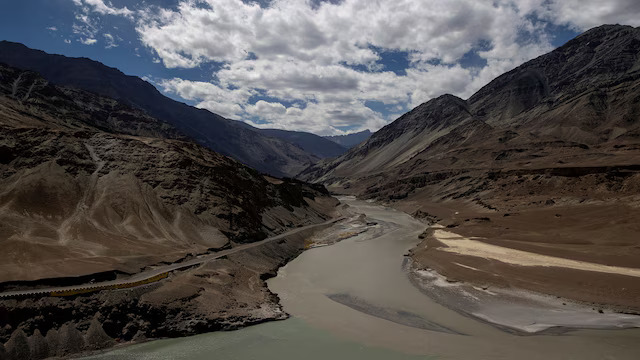
Courtesy: Express Tribune
Hassan F. Virk
Most of China’s neighboring countries have either been turbulent or economically weak and that makes them dependent on the regional hegemon. China’s one-size-fits-all message to the neighbors is: whatever your problems are, Chinese investment is the solution. For China it is methodical geopolitics and, according to David Harvey, “a spatial fix to its surplus problem” but it exacerbates socio-political problems in the recipient countries. The transport corridor between Pakistan and China traverses Jammu and Kashmir, the status of which has been contested since long; and, pro-Pakistan bias on China’s part is placing additional strain on India-Pakistan relations.
In the historical context of irredentism, China had its own issues with the colonial cartography carried out on Kashmir by the British Empire. During the 1950s China corresponded with India and Pakistan about its historical claims over the pieces of Kashmir that had been arbitrarily included in the maps of British India. The two nascent states had responded with their own stories of spatial injustice done to them by the parting Raj which squandered their rightful claim over entire Kashmir. China kept its calm and quietly begun constructing a road connection from Tibet to Xinjiang via Aksai Chin in 1956. China’s construction of this road – which resulted in the Tibetan Uprising (1959) and the beginning of India’s encirclement fear- was one of the triggers of the 1962 Sino-Indian conflict. Pakistan, eyeing an opportunity to strategically position a strong ally against India, ceded the Shaksagam Valley or the Trans-Karakorum Tract to China in 1963.
Fast forward to 2015, there is another road, which is going to be an economic corridor between Pakistan and China snaking through the long contested space of Jammu and Kashmir, and there is India with its fears of the dragon and Pakistan. There is a looming threat of another conflict with China over the territorial limits of Ladakh. If CPEC is not déjà vu, then what is it?
Chinese policies across its borders can result in major alterations in the regional geopolitical milieu. Due to CPEC, Pakistan has got a significant position in China’s foreign policy; and China due to its claim on Ladakh, having a third-party role in the Kashmir dispute, directly influences the thawing process of this frozen conflict. With India-China relations getting tense, it is unlikely the boundary disputes will be resolved soon. The timing of India’s annexation of Kashmir in August is a ruse for bringing escalation and chaos in motion to safeguard against the dragon’s snare.
A new U.S.-India military cooperation is brewing in the region, pin located in Ladakh, to meet the growing Chinese military might and to transform Ladakh into Washington’s strategic stronghold to check China’s influence and to monitor Russia.
Daulat Beg is the existing Indian military base, located on the ancient trade route connecting Ladakh to Tarim Basin in the Xinjiang region. While Ladakh will now be an Indian Union Territory without a local legislative assembly, the step to install an Indo-U.S. strategic base would be comparatively much easier. Currently, the border tensions between China and India are minor, as evidenced in the recent brawl near the northern bank of Pangong Lake, which extends from Tibet to Ladakh; this military standoff was so trivial that a brigadier level meeting resolved it. But the situation could escalate soon as India is about to launch the biggest military drills with about 15,000 soldiers, including air force personnel, in the disputed Arunachal Pradesh, near the Chinese border, which for China is South Tibet.
China’s Share of the Himalayan Chaos
How can China’s subtle thought and policy process be deciphered? China’s take on Kashmir and Ladakh is based on a balance between the Chinese ambition of regional hegemony and safeguarding economic interests above all. Since August 5, China has played very cautiously: it has reiterated support for Pakistan and also highlighted its claim over Ladakh. On the Indian annexation of J&K and Ladakh, the Chinese Foreign Ministry spokesperson stated, “China always opposes India’s inclusion of Chinese territory in the western section of the China-India boundary under its administrative jurisdiction… this position is firm and consistent and has never changed. The recent unilateral revision of domestic laws by the Indian side continues to undermine China’s territorial sovereignty, which is unacceptable and will not have any effect.”
For an uninterrupted completion of CPEC projects and to move on to the construction of oil conduits, China asked Pakistan to find a way out of conflict, without involving China. And India too reaffirmed its adherence to the Sino-Indian Line of Actual Control in Ladakh and elsewhere. However, Indian Minister of External Affairs Subrahmanyam Jaishankar clarified on 18 September that India has not renounced its sovereignty claims over Aksai Chin. To make matters worse, Indian Home Minister Amit Shah declared that, “I want to make it absolutely clear that every single time we say Jammu and Kashmir it includes Pakistan-occupied Kashmir, including Gilgit-Baltistan, as well as Aksai Chin. Let there be no doubt over it. The entire Jammu and Kashmir is an integral part of the Union of India”, stirring up a hornet’s nest.
Sino-Indian rivalry is deeply rooted in history. Sino-Indian War of 1962 was caused by a number of post-World War II developments involving two newly emerged regional entities, both striving for power in the post-war, postcolonial order. Mao and other Chinese leaders viewed the bourgeoisie India as part of the anti-China tide sponsored by the capitalist enemies, while Nehru propagated the fear of Chinese expansionism. Chaowu Dai, Professor of History affiliated with the Wilson Center, identified three stages of Beijing’s approaches to border issues before it used the kinetic option: The first stage, from 1951 to 1954, was of “temporary maintenance of the status quo”. In the second stage, from 1955 to April 1960, China prepared to settle and proposed an East-West territory swap, with China’s recognition of the McMahon Line as a prerequisite. In the third stage, from May 1960 to October 1962, seeing on India’s part an unwillingness to negotiate and also the scattering of troops and outposts in the mountains under Nehru’s ‘forward policy’, China went for deployment of its military with a war plan to “never yield while striving to avoid bloodshed, create interlocking positions for long-term armed coexistence.” It tore apart India’s thin defenses. The defeat in 1962 changed the Indian mindset about China. Bilateral ties between the two countries were restored in the 1980s and in a few decades China became the biggest trading partner of India. However, China’s muscle-flexing from the Indian state of Arunachal Pradesh to building military bases in the immediate neighborhood of India has continued.
China does not really have any hostile borders other than in the Himalayan corridors. As of February 2019, Ladakh was demarcated as an autonomous revenue entity, while China continued to exercise sovereignty over Aksai Chin, and there were even prospects for a China-India Economic Corridor. But, in the wake of August 5 actions, India declared that it has the right to expect China to respect its sovereign claims over Ladakh and Aksai Chin just as China expects India to accept its claims over Tibet, Taiwan and Xinjiang as part of the ‘One China’ policy.
A month later at the 74th session of UNGA, China’s state councilor and foreign minister has called for a peaceful resolution of Kashmir issue in accordance with the UN Charter, Security Council regulations and bilateral agreements. India, already infuriated with PM Khan’s speech at the same venue, reacted to this very reasonable suggestion by calling CPEC an ‘illegal’ project. After all, the amount of restraint China has exercised over the past two months, such a libel against China is bound to bring about the desolation of the dragon. One thing should be clear, China with its ever ready People’s Liberation Army, will not shy away from engaging in a military conflict if challenged but it might consider if Kashmir or Ladakh is worth going to war for with India? Maybe not Kashmir but Ladakh definitely is.
China wants the war in Afghanistan to end and it also wants to avoid a future war in Kashmir. War would mean immediate suspension of CPEC operations and evacuation of the Chinese from the whole region. Also, the prospect of China’s war with India could start domestic eruptions within China. The decades-long strife in the Himalayan corridors over virtually uninhabited and inhospitable tracts of land calls for a rethinking of this region’s vulnerability. Conflicts erupt in South Asia due to contradictory pressures from spatial integration and differentiation which include armed and legislative measures for territorial re-divisions, mergers, and spatial development disparity. It is time the three nuclear armed countries who share hostile borders, focus on dialogue and confidence building measures to resolve their outstanding conflicts.
Hassan F. Virk is Lecturer , School of Integrated Social Sciences, University of Lahore.







